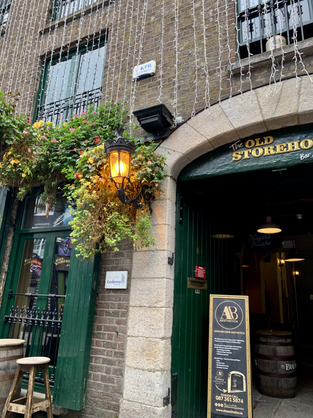A Pedacito of Dublin, Ireland
- Alex Gerlach
- Apr 9, 2021
- 4 min read
Updated: Jun 19, 2022
My favorite description of Dublin has to be one made by a faculty member from my alma mater: Dublin is to London what Philadelphia is to New York City. Being an abroad student living in London, I understood exactly what they meant when I landed in Ireland’s historic capital. Dublin embodies a more urban, eclectic, and “hometown” atmosphere compared to the metropolitan, “big city” feel of London.

We arrived at the city center one Friday evening after about an hour's flight from London. We made our way through the well-maintained center and the flow of traffic to Temple Bar. On the way, we walked along one of the rivers that run into Dublin Bay and passed the buildings being reflected in the water.
Temple Bar is a busy area along the riverside filled with quirky boutique stores, pubs, and plenty of venues with live local music. It gets its name from Temple Bar, a famous pub established in 1840 that offers Ireland’s largest collection of over 450 rare whiskies. The cobblestone streets are filled with bars that are also called Temple Bar, so make sure you find the right one.

A quick tip! Temple Bar is a great area of Dublin to experience and is a must-see for any traveler. However, Temple Bar is notorious for very pricey pints of beer. A tour guide suggested we visit quieter parts of the cities with more locals for a true Dublin experience over a much cheaper pint.
The next day, we joined one of the free city tours that was offered by our hostel. I found across all of my trips that hostels were the best and cheapest places to stay and often host free tours, bar crawls, and other events. It’s a great way to meet and mingle with people from all over the world. If you do decide to join one of the free tours, it's important to note that the tour guides do not make any commission and it’s polite to tip them at the end of the tour.
The tour guide brought us first to the Dublin Castle, called the Caisleán Bhaile Átha Cliath in Gaelic. We learned that most of the original constructions in Dublin were burned down, so much of the original city was rebuilt to replicate what it looked like centuries ago. The Dublin Castle was no exception when a fire in April 1684 burned it down, taking many historical documents with it. In fact, our tour guide shared that another fire was purposefully set to initiate reconstruction of the entire castle years later.

The Dublin Castle features a few key parts including the Record Tower, State Apartments, the Bermingham Tower, George’s Hall, and the President’s Suite. The interior of the castle was closed during our visit, but we still learned about the interesting history of Dublin standing outside in the open square. For example, we learned that in the 80’s Dublin was experiencing a drop in tourism and decreased global interest in the city. To overcome this, they proposed celebrating the Dublin millennium to celebrate 1,000 years of the city’s history in 1988. However, there is no actual birth date for the city and Dubliners agreed to stay quiet about it so they could cash in on the tourism boom.


Behind the castle is the Dubh Linn Garden, a grassy sward with swirling patterns cut into the yard meant to represent sea serpents. The site is named after and sits on the original dubh linn, or black pool, where the Vikings originally harbored their ships and set up a trading port. This pool is the heart of the city and gave it its name Dublin.

After the walking tour, we went to the Guinness Storehouse for a tour of the brewery and the history of the Guinness brand. The storehouse is located west of the city center and Dublin Castle, away from the busier streets and nestled in an artistic neighborhood. You know you’re there when you stand on the cobblestone street in front of the famous Guinness gate. Once inside, the tour begins.
For a flat rate, you get a tour of the storehouse and learn about how Guinness is brewed. There are tons of interactive exhibits as you make your way steadily up the building. In the end, you can go to the rooftop bar for a free full pint of beer overlooking the city. My favorite part of the tour was meeting my birthday twin, which was the first time I’d ever met someone who shared the same birthdate as me!
There is so much more to see in Dublin, such as the historic St. Catherine’s Church of Ireland and Trinity College. There are also tons of whiskey distilleries, like the Jameson Distillery which offers a tour and tasting. Dublin is a quirky and unique city that is definitely worth the visit. Happy travels!
Plan and prepare for your trip to Ireland by reading experiences from our other storytellers! Check out their stories here.
Want to know more? Are you interested in becoming a contributor for Pedacitos? We'd love to hear your stories! Send me a message and I will get back to you!





























Comments